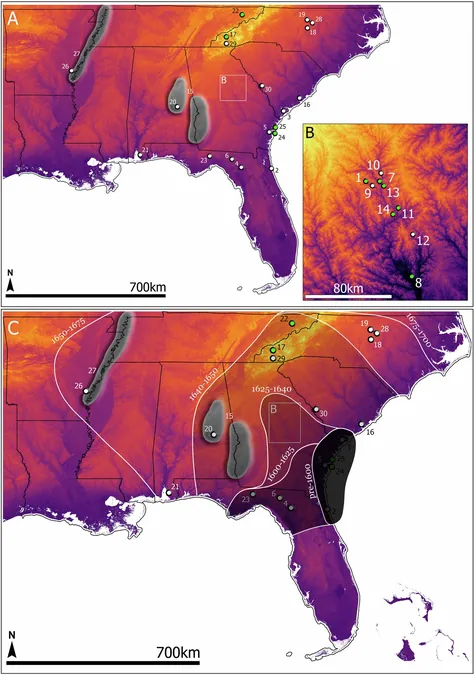
How Indigenous Networks Transformed Peaches into America’s Beloved Summer Fruit
2024-11-22
Author: Amelia
Introduction
Spanish explorers may have introduced the first peach pits to North America, but a groundbreaking study reveals that it was Indigenous communities that truly nurtured this summer staple, allowing it to flourish across the continent. Researchers at Penn State have shed light on how Indigenous social and political networks, along with unique land management practices, were crucial to the peach’s adoption and dispersal.
Research Findings
Published in Nature Communications, the study led by anthropologist Jacob Holland-Lulewicz reveals a more complex narrative than previously understood. "Peaches require care to thrive—optimal sunlight, suitable soil, and regular pruning," said Holland-Lulewicz. "For years, the history depicted peaches as spreading rapidly after their introduction by the Spanish. However, we now know that this spread was intricately tied to Indigenous land management strategies."
Historical Evidence
The research team meticulously reviewed historical documents such as the travel accounts of French missionary Jacques Marquette and English merchant Jonathan Dickinson, alongside employing radiocarbon dating techniques. By analyzing organic materials from 28 archaeological sites in the southeastern United States, including areas in the Carolinas, Georgia, Florida, Alabama, Tennessee, and Arkansas, they uncovered evidence that peaches were widespread in Indigenous settlements as early as 1620—only a century after the earliest Spanish expeditions.
Cultural Interactions
The findings suggest that early Spanish settlements transformed into vital trade hubs, which, when intertwined with Indigenous networks, created favorable conditions for peaches to thrive. Holland-Lulewicz points out that initial European encounters did not cause immediate cultural upheaval. It wasn’t until Spanish and Indigenous networks began to interact that the conditions emerged for the widespread cultivation of peaches.
Archaeological Discoveries
Additionally, the researchers identified what may be the earliest known peaches in North America, dating back to a Muskogean farmstead in Georgia's Oconee Valley. Archaeologist James Hatch previously discovered peach pits at the site in the 1990s. Radiocarbon dating of other materials indicates that this farmstead was operational long before the founding of St. Augustine in 1565, suggesting a rich history of peach cultivation among Indigenous peoples.
Significance of Indigenous Stewardship
Victor Thompson, a co-author of the study and Distinguished Research Professor at the University of Georgia, emphasized the importance of understanding the historical context of species introductions, particularly how Indigenous peoples shaped these narratives. “This research highlights the profound influence of Indigenous communities and their environmental stewardship on broader American agricultural history. It also underscores the importance of maintaining our museum collections for future research."
Cultural Legacy of Peaches
Indigenous peoples not only adopted but also selectively cultivated new peach varieties, surpassing those available in Europe at the time. "By the mid-1600s, Europeans noted that Indigenous communities had developed extraordinarily diverse peach orchards," Holland-Lulewicz remarked. "In some cases, these communities had never even encountered Europeans before."
Continued Cultural Connection
Peaches became so deeply embedded in Indigenous culture that the ancestors of the modern Muscogee (Creek) Nation took them along during forced migrations in the 1800s. "Today, many Muscogee (Creek) people continue to grow peaches as a vital part of their heritage," Holland-Lulewicz said. "The tradition of cultivating these peaches, originating from the 1500s and 1600s, remains an important cultural practice that connects past and present."
Conclusion
This remarkable fruit, once thought to be solely a European transplant, stands as a testament to the innovative agricultural practices of Indigenous communities and their integral role in shaping America’s food landscape. As the summer season approaches, it’s essential to recognize and celebrate the historical roots of peaches and the cultures that have cared for them.









 Brasil (PT)
Brasil (PT)
 Canada (EN)
Canada (EN)
 Chile (ES)
Chile (ES)
 España (ES)
España (ES)
 France (FR)
France (FR)
 Hong Kong (EN)
Hong Kong (EN)
 Italia (IT)
Italia (IT)
 日本 (JA)
日本 (JA)
 Magyarország (HU)
Magyarország (HU)
 Norge (NO)
Norge (NO)
 Polska (PL)
Polska (PL)
 Schweiz (DE)
Schweiz (DE)
 Singapore (EN)
Singapore (EN)
 Sverige (SV)
Sverige (SV)
 Suomi (FI)
Suomi (FI)
 Türkiye (TR)
Türkiye (TR)